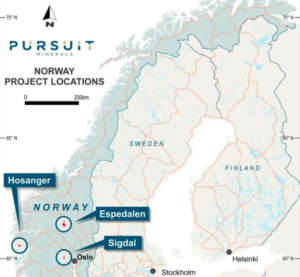You might be interested in
Mining
As Chalice scales record highs on its monster Julimar resource, how are its nearologist friends going?
Mining
These 12 ASX explorers are betting that Julimar 'nearology' is more than just a common post code
Mining
Special Report: Pursuit is confident that its new nickel projects will gain traction at a time when demand for the metal in batteries is rising rapidly.
When the new chief executive officer of the world’s largest mining company highlights their interest in the same minerals that you are pursuing, it is quite likely that you have hedged your bets right.
Pursuit Minerals (ASX:PUR) is likely then to be patting itself on the back after BHP (ASX:BHP) boss Mike Henry said last week that BHP needed more options in “future facing” metals such as copper and nickel.
After all, Pursuit had just announced one day before Henry’s comment that it had entered into a 12-month option agreement to purchase a 100 per cent interest in three advanced and highly-prospective nickel sulphide projects in Norway.
The Espedalen, Sigdal and Hosanger projects in southern and west-central Norway are geologically analogous to Voisey’s Bay in Canada, one of the world’s largest and best nickel deposits.
To top it off, the centrepiece of this acquisition – the Espedalen project about 50km northwest of Lillehammer – contains one of those qualities that is always in demand, an existing resource.
Espedalen contains two nickel deposits with defined resources though the company’s attention is focused on Stormyra, which contains an inferred resource of 1.16 million tonnes at 1 per cent nickel, 0.42 per cent copper and 0.04 per cent cobalt.
“That deposit already exists and what the company will now do is look for extensions to that deposit because there is a high-grade portion to the resource grading 2 to nearly 3 per cent nickel,” Technical Director Jeremy Read told Stockhead.
“That hasn’t been fully explored so there is potential there to not only grow the resource but also to increase the overall grade of the deposit.”
And that’s not all, Espedalen also includes the lower-grade Dalen prospect that has an inferred resource of 7.8 million tonnes at 0.28 per cent nickel, 0.12 per cent copper and 0.02 per cent cobalt, as well as 10 other prospects where previous explorer Blackstone Ventures made intersections of at least 5m grading more than 1 per cent nickel.
“Those intersections have not ever been followed up, so that’s a really good set of targets for us to follow up on and they give us a big head start in comparison to many other nickel projects,” Read noted.
Pursuit is planning to secure approvals to conduct a drill program to expand the Stormyra resource with a particular focus on the higher-grade portion as well as the exploration prospects drilled by Blackstone, but never follow up on.
“Part of the work we want to do is build on what has been done and to test the potential for one of the projects to turn into a giant deposit,” he added.
“We have some nice nickel and copper grades plus some relatively high cobalt grades. So, some good by-product credits there in addition to the quality nickel grades at Stormyra.”

Read also emphasised the benefits of operating in Norway, noting that it has a very long involvement with the nickel industry along with one of the world’s largest nickel smelters in southern Norway.
Glencore operates the Nikkelverk nickel refinery at Kristiansand, which has been refining nickel concentrate and exporting nickel products since 1910.
All three projects are accessible by tarmac roads, while Estedalen has both grid power and is 20-30km away from a railway that links it to southern Norway and the Nikkelverk refinery.
Additionally, Norway has the greatest uptake of electric vehicles (EVs) on a percentage basis, with EVs accounting for a 44.3 per cent share of its new car sales in January, according to the Norwegian Road Federation.
“Batteries and electric vehicles require a lot of nickel and so if you are going to turn over your vehicle fleet into electric vehicles, you are going to need a lot of batteries, which in turn will need a lot more nickel and the Norwegians understand this,” Read explained.
“We are working in a country where they understand that the transition over to electric vehicles and renewable energy will require a lot more lithium, nickel and copper as well.
“Norway is a jurisdiction that is leading the world in that and they understand the implications of what that means for they key battery metals that goes into making batteries.”
Read: EV manufacturers used 28pc more nickel per car in 2019, Adamas reports
Besides Espedalen, Pursuit’s acquisition option includes the Sigdal and Hosanger projects.
Sigdal contains a geophysical conductor associated with historical mine workings.
It has only been tested with two short drill holes, though one of these returned gold grades of more than 10 grams per tonne along with encouraging nickel and copper mineralisation.
Further drilling of the conductor will be carried out to determine the thickness and extent of the mineralised horizon and to follow up on the high-grade gold intersection.
Meanwhile, Hosanger contains the Litland nickel mine that produced 460,000 tonnes of nickel ore grading 1.05 per cent nickel, 0.35 per cent copper and 0.05 per cent cobalt from 1915. This remains open at depth.
Pusuit will evaluate the historical mine and 50 exploration holes completed within the Hosanger project area before selecting targets for follow-up drilling.
The company has to pay $US25,000 ($37,866) cash, issue 20 million shares and spend at least $US250,000 on exploration within 12 months in order to exercise the option to acquire the projects.